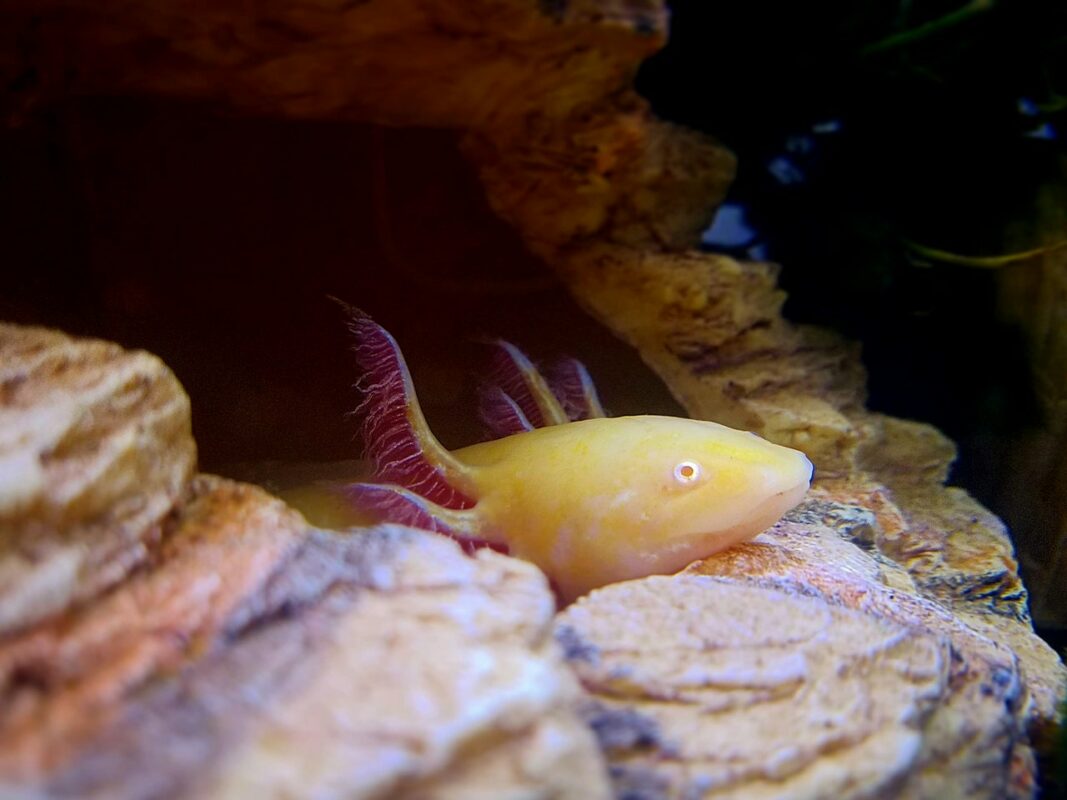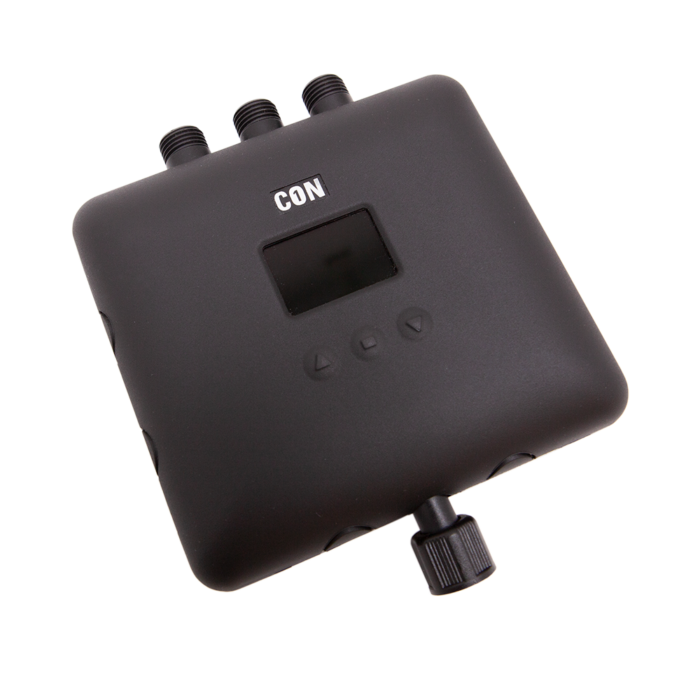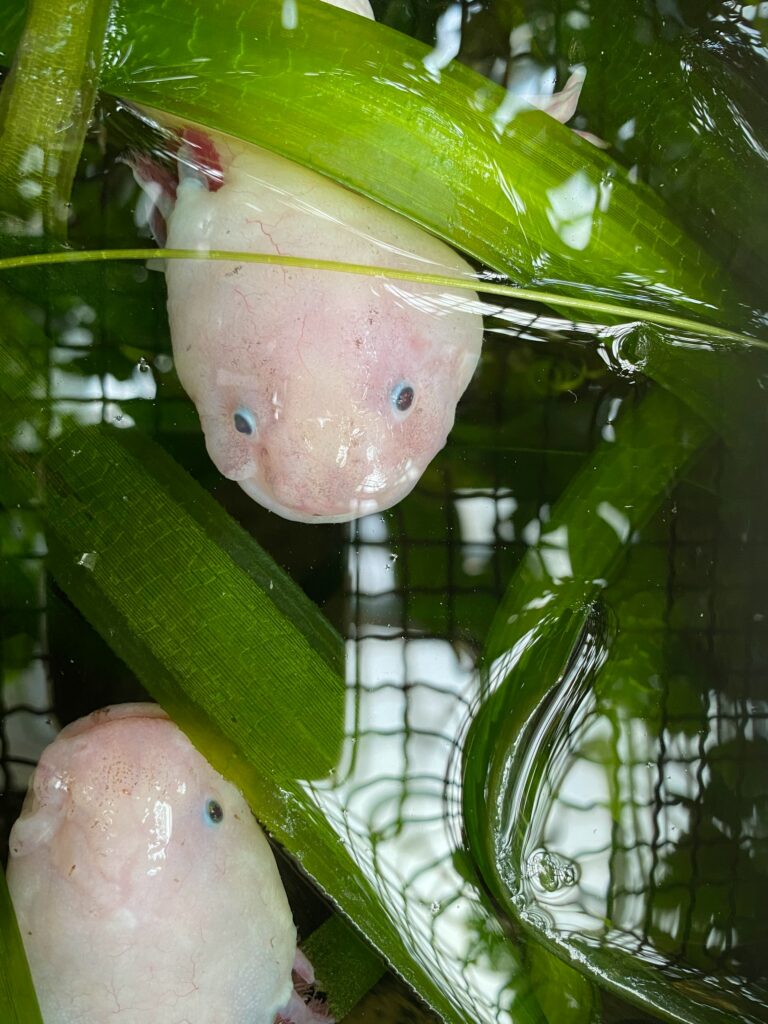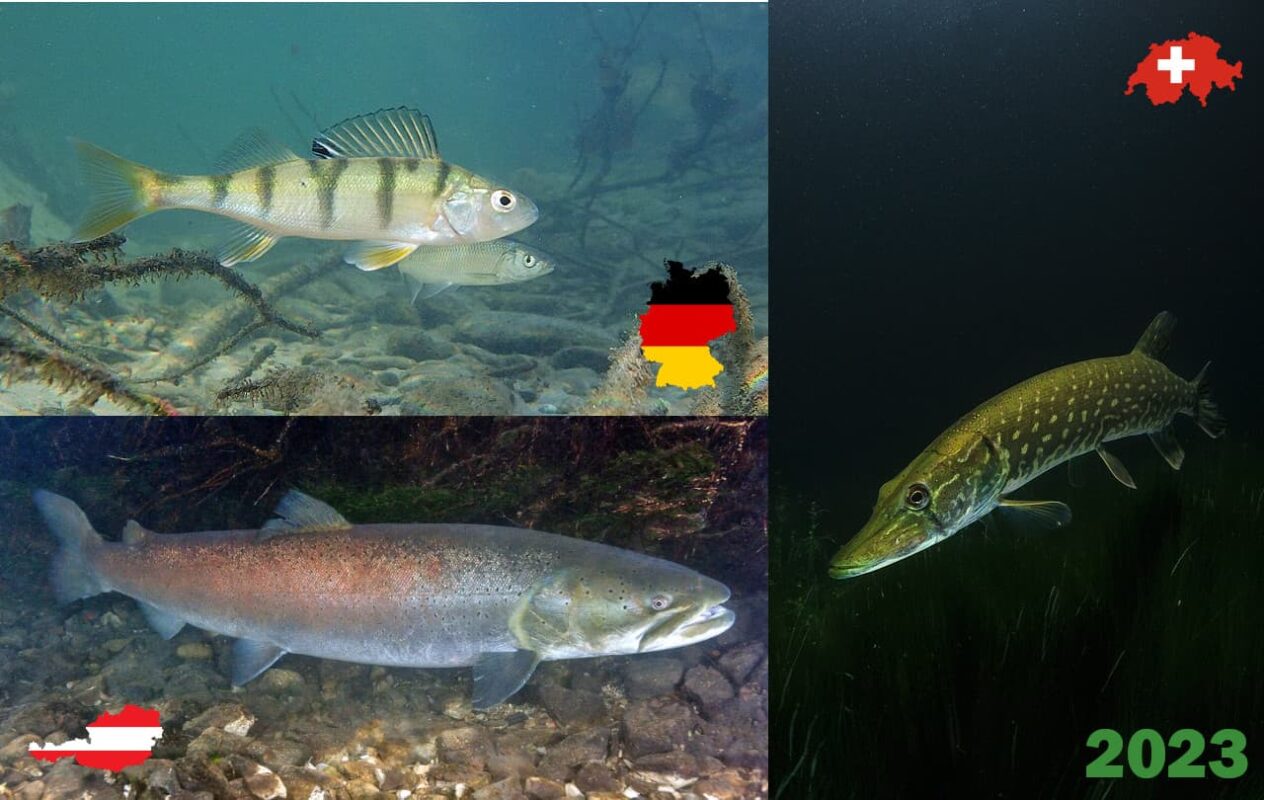What are Axolotls?
Axolotls, sometimes affectionately referred to as ‘water dragons’, belong to the genus Ambystoma. Many species of these so-called ‘mole salamanders’ share a genetic quirk that delays the metamorphosis into their adult forms, remaining larvae for far longer than typical for other amphibians. Axolotl are the most famous example of this, and, in nature, retain their larval forms throughout their entire lives. They are strictly aquatic and are kept exclusively in aquariums without land.
At up to 30 cm in size, they also get quite large. And: Axolotls never stop growing!
Incidentally, axolotls are considered a cult animal in Mexico: they are regarded there as a kind of ‘sacred animal’, and have also been enjoying growing popularity in Europe for some time now.
Unfortunately, the species is critically endangered, mainly due to pollution and loss of habitat.
If you would like to give one or more axolotls a new home, there are a lot of important points to consider!
Firstly, buy your animals from responsible breeders who do not breed ‘wildly’ but pay attention to the genetics: Most axolotls kept today carry some amount of tiger salamander genes — some colour variants in particular would not be possible without this. The disadvantage of this is that excessive cross-breeding or ‘wild’ reproduction can result in the animals not remaining in the larval phase, but instead undergoing spontaneous metamorphosis. The animals rarely survive this and afterwards require a different terrarium setup, and often suffer a reduced quality of life still. Therefore, you should under no circumstances buy axolotl eggs, not only is raising them anything but easy — with eggs it is mostly up to chance whether you will end up with viable, robust and healthy animals. In addition to the suffering of the animals, this can also result in considerable follow-up costs!
The Tiny Dragons’ Particularities
The aquarium must not be treated with starters or other chemical-biological aids, so you should expect a possibly long maturation time.
Cool Temperatures
As mentioned, axolotls must be kept in relatively cool temperatures. There are several reasons for this: Firstly, their biology means that they are simply adapted to very cold water. In warmer water, they age more quickly and fall ill more easily. This is in part due to their immune defence relying on certain substances in their mucus coating. However, these defensive peptides in the mucus only work at temperatures below 20 °C.
The BD fungus (Batrachochytrium dendrobatidis)
When building an aquarium system for axolotl, every component must be ‘Bd-free’ and/or treated. The chytrid fungus is unfortunately now a very widespread fungus that is fatal to axolotls. Its spores are typically carried in with aquarium furnishings, stock, or the animals themselves. The problem is very widespread, which is why it is advisable to buy aquarium equipment new.
If second-hand materials are used, they must be thoroughly disinfected with a special disinfectant (e.g. Virkon S). Important: Hoses etc. cannot be disinfected as the toxic agent soaks into the material. Plants and any food animals such as guppies, shrimps or snails must come from guaranteed BD-free stock or (in the case of plants) be grown sterile. The axolotl should be tested for BD before being introduced into the aquarium and annually thereafter. Swab kits are used for this purpose; you carefully take a swab from the animals and send it to the appropriate laboratories for analysis.

Tips:
Please do not underestimate the topic of chytrid fungus: once you have ‘caught’ the dangerous fungal germ, the effort required to clean and disinfect the entire aquarium system is considerable. Therefore, always err on the side of caution and only use treated equipment/components and animals/plants that have been bred sterile or come from regularly tested chytrid-free stock.
And make sure to protect our wild amphibians too: never allow infected aquarium water to simply enter the environment — always sterilise it first by adding chlorine bleach, Virkon S or benzalkonium chloride. In many places, salamander and newt populations have already died out because batrachochytrium strains have found their way into nature. And once the fungus has been released, it can not be removed again — with devastating consequences for our valuable wildlife.
What Do I Need to Keep Axolotls?
Now, if you have fallen in love with these quaint little water dragons and would like to acquire some, you will definitely need a large aquarium, preferably at least 100 cm x 40 cm for 1–3 animals.
A Good Chiller is Vital!
Equally important and only dispensable if you want to place the aquarium in a cool cellar is a flow-through cooler. Axolotls prefer it cold, which is why the water temperature should be a maximum of 20 degrees Celsius, and even lower in winter.
Only a flow-through cooler can reliably provide such cool temperatures; all other makeshift solutions regularly fail. You should therefore budget for the purchase and operation of a sufficiently dimensioned cooler right from the start.
Pump and Lighting
Your choice in cooling also sets the requirements for the right pump and filter. It is important to choose those that are designed directly for the required cooler. The lighting, on the other hand, can be somewhat more economical. As the animals prefer darker waters, the lighting is only particularly important for the plants. The small dragons often get startled when the lighting is switched on abruptly, especially when the light is very bright, so it is best to slowly raise and lower the lighting using a control unit.
SOLAR STINGER® / SOLAR RAPTOR® CON1
- Steuergerät
- Für alle SolarStinger- & SolarRaptor-Produkte mit DRV Netzteilbetrieb
- Zum Kreieren von Sonnenauf-/Sonnenuntergang und andere Szenarien
- 3 individuell steuerbare Ausgänge zum Anschluß von mehreren Produkten
Special Gravel
As axolotls ‘suck in’ their food when eating, they always ingest substrate as well. The gravel in the axolotl aquarium must therefore be suitable for problem-free gastrointestinal passage. This means in particular that the individual stones should not only be of a tolerable size (grain size under 3 mm) in order to pass through the intestines easily, they must also be consistently rounded so that no internal injuries can occur. In addition, the gravel should not contain any colouring or plastic coating. Smooth natural gravel or special Axogravel has proven itself.
Chytrid-treated or Sterile Aquatic Plants
There are also special requirements when it comes to vegetation: Because aquatic plants grown in ‘normal’ aquariums unfortunately all too often carry the Bd fungus, which is harmless to other animals but unfortunately deadly to axolotls, the plants for axolotl aquariums must either come from special, monitored farms, be grown in sterile conditions or be extensively pre-treated with a special disinfectant before they can be placed in the aquarium.
By the way: Axolotl like to ‘rearrange’ their aquarium from time to time, e.g. because they dig up plants. You should generally keep the paths along the glass clear for them.
It has also proven helpful to tie individual plants to the caves (if the plant can withstand this) to deny the animals their more ‘artistic use’.
Burrows
You should offer each animal a spacious cave without any sharp-edged areas. It is important to make sure that there are no openings that are too small for the animals to get stuck in – axolotls are sometimes a little clumsy or “almost tired of life”. Any openings in caves that are too small for them to swim through should therefore be closed with moss balls to be on the safe side.

Plastic boxes for quarantine housing
If a new axolotl arrives, becomes ill or is injured, the animal is placed in a quarantine box. This should not contain gravel or caves, but only fresh water, and sometimes salt baths or treatment with medication may also be necessary. All of this requires appropriately sized plastic boxes, which you should ideally get right at the start – that way you have a suitable box to hand in case of a problem.
Diet
Axolotls are carnivores, small specimens are fed with mosquito larvae, large axolotls are fed with dew worms or earthworms. Guppies or shrimps and small snails can also be fed, as well as freshwater fish cut into small pieces. Under no circumstances should you feed saltwater fish, however, as these contain high levels of iodine, which can trigger metamorphosis.

Attention:
Also bear in mind that if you use earthworms you have caught yourself as food, you could very easily introduce the BD fungus or other infectious germs into your aquarium. You are on the safe side with purchased dew worms. You can easily breed these yourself.
As an alternative to live food or fresh fish, there are also special pellets for feeding axolotls. However, there are also some varieties on the market that are not well tailored to the needs of the animals (for example with plants/grain in the recipe).
Keeping females and avoiding breeding
The sex of the axolotl can only be determined once it has reached a certain size. This is another reason why it makes sense not to buy animals from breeders that are too small. While males can be kept alone or with several “among themselves”, females should not be kept without at least one male. Otherwise, this can lead to them becoming eggbound, which can be life-threatening. When keeping females, the combination of two females with one male has proven to be successful.
In this case, the females regularly lay eggs. It is then best to simply leave the eggs and the hatching larvae in the aquarium – they will be eaten by the adults and unwanted breeding will be prevented “naturally”. However, it must be ensured that the larvae are not sucked into the filter and then die an agonizing death. It is therefore advisable to secure the intake pipe with fine gauze at times when eggs/larvae are in the aquarium.
Socialization
Axolotls like to keep to themselves – and preferably only animals of approximately the same size. If you keep animals of different sizes together, they can easily bite each other.
Socializing with some fish also often leads to problems, for example catfish “suck off” the protective mucous membrane and thus injure the axolotl. The animals suffer greatly as a result and can also become seriously ill. Unfortunately, bites (bite injuries caused by fish that “pluck” the axolotls) are also not uncommon.
Fish stocking must therefore always be geared towards ensuring that there is no danger to the axolotl. This also applies to the risk of introducing germs or the BD fungus.
Conversely, the mandatory low water temperature for axolotls also prevents them from socializing with fish species that require warmer water for animal welfare reasons. After all, even food fish, as vertebrates, must be kept in a species-appropriate manner by law, but of course also for fundamental animal welfare reasons!
If at all, axolotls are usually “socialized” with shrimps and/or guppies. However, both are food animals rather than true companions, and guppies need temperatures of 20 °C and above to feel comfortable. A plus point is that these days there are also offers for such food animals from guaranteed BD-free stocks.
The most suitable shrimps are robust dwarf shrimps that reproduce readily. These should also be obtained from BD-controlled breeding. In order for the shrimps to stand a chance against the axolotl, they need dense planting, at least in places – otherwise the water dragons could have “cleared away” the shrimp stock in just a few hours.

Tips:
If you want to offer your axolotls guppies and shrimps regularly, it is best to set up a separate breeding tank in which you produce your “own supply” based on a few BD-free guppies and dwarf shrimps. In the long run, this will be much cheaper than constantly having to buy more — especially as live animals cannot be shipped in the hot summer and the supply could then also run out when buying from a specialist breeder.
Other candidates for a companionship with fish are cardinalfish or zebrafish, both of which also feel comfortable at 18 °C, which is just about in harmony with the optimum aquarium temperature for axolotls.
Snails are also often mentioned as good roommates. However, it must also be noted here that axolotls could be endangered: As they eat the snails but do not digest the houses, only small and round-shelled snail species are suitable. Bladder snails or Ramshorn snail are therefore usually mentioned as suitable – the latter, however, can cause serious problems for axolotls if swallowed if they are too large!
Similar animals:Anderson’s salamander (Ambystoma andersoni)





